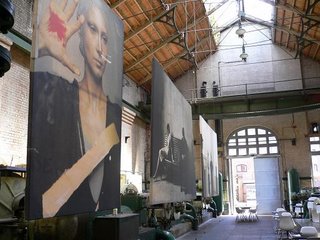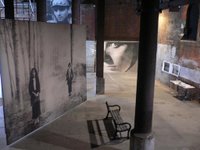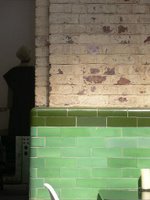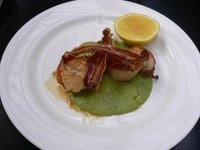 It took the promise of Deborah Turbeville to finally get me off my arse and over to The Wapping Project. I'd been meaning to go there but never quite got round to it. The chance to see D.T's work up close and not just on the glossy pages of a magazine was the incentive I needed. I was expecting The Wapping Project to be a bit wanky and pretentious to be honest. A converted hydraulic power station, it sits just behind the river Thames on a cobbled street, amongst shockingly expensive, beautiful wharf and Victorian loft conversions. Unfortunately Wapping also has its fair share of heinous crimes against architecture - known as the 'Luxury Executive Riverside Development'. I feel sorry for the aesthetically sensitive millionaire folk who live in the nice converted wharves on the river but have a view of these hideous floating casinos. Well, actually not that sorry. The Wapping Project is also bang opposite the oldest riverside pub in London, The Prospect of Whitby, which is pretty damn lovely, with a long zinc bar and a beer garden on the water.
It took the promise of Deborah Turbeville to finally get me off my arse and over to The Wapping Project. I'd been meaning to go there but never quite got round to it. The chance to see D.T's work up close and not just on the glossy pages of a magazine was the incentive I needed. I was expecting The Wapping Project to be a bit wanky and pretentious to be honest. A converted hydraulic power station, it sits just behind the river Thames on a cobbled street, amongst shockingly expensive, beautiful wharf and Victorian loft conversions. Unfortunately Wapping also has its fair share of heinous crimes against architecture - known as the 'Luxury Executive Riverside Development'. I feel sorry for the aesthetically sensitive millionaire folk who live in the nice converted wharves on the river but have a view of these hideous floating casinos. Well, actually not that sorry. The Wapping Project is also bang opposite the oldest riverside pub in London, The Prospect of Whitby, which is pretty damn lovely, with a long zinc bar and a beer garden on the water. So - I arrived at The Wapping Project just around lunch time (you can park there for free and it's not in the CC zone - total bonus) expecting it to be full of braying pseudo creative types who long ago sold their souls for a luxury wharf and a custom BMW, tapping away at Macbooks whilst simultaneously eating and talking on the phone. But no, it was completely empty and I was welcomed by the sweetest staff who enthusiastically told me all about the exhibition, the space and the lunch menu. And wow, what a space! Sunlight streaming in from all sides, I can honestly say this was the most beautiful former industrial building I've ever set foot in. Just really, completely stunning. Still with rusty girders, peeling paint and cracked tiles, the soul of the building was intact - you know when you go somewhere and it just has a really good feeling? I can't explain it better than that.
And Deborah Turbeville's work sat so perfectly within that space, the graininess, the detail of the individually worked 35mm negatives blown up to a huge scale, against the background of this building...I had to go round twice. I'll stop gushing for a sec and show you some photos I took...





I was already a big fan of Deborah Turbeville's work so it was great to see this and get the back story. It put the work of what I had previously considered a somewhat mysterious visionary into context. In a very condensed nutshell the story goes that 'discovered' by American designer Claire McCardell she worked as her sample model/assistant at a time when McCardell was the most important designer in the U.S. Diana Vreeland then gave her a job as an editor at Harper's Bazaar but it soon became clear that "she had a special vision that could not be contained". Richard Avedon took her on as his protege after she showed him some of her photographs taken on a shoot she was styling. Her six month training with him was the only photography class she ever took.
I feel I don't want to refer to D.T as a fashion photographer, although there's nothing wrong with being one. Her 1975 'Bathhouse' series published in American Vogue is iconic as is her work in Vogue's Italia, Paris and U.S and other magazines over the years - but her photographs are not really of fashion, they don't scream it. They are pictures of people, in haunting, dreamy settings. The clothes are most definitely not the main character. She says "Fashion magazines should be about raising the standard - but now because of the demands of advertisers they have to stoop to fit in with everything else." Amen.
I loved the way the images were shown, some blown up as canvases, but others collaged together loosely with pins, or hung on taut wires with bulldog clips, along with quotes scrawled in pencil on parchment paper. I felt I got much more of an insight into her process by it being presented in this way. The antithesis of your average, 'if you blow up any bog standard ordinary photo and stick it on a blank white wall in a gallery setting it will look great' mentality.
I haven't even mentioned the food have I? Well The Wapping Project is known for the food. They do Sunday brunch which I will probably never experience since they stop serving it at 12 noon. I won't lie - the food is expensive. They do lunch, afternoon tea and dinner during the week and brunch, lunch and dinner at the weekend. It's all completely open plan so I watched the chef preparing my lunch - I just took a starter and that was £7.75. But does the gushing stop with the food? Nope. I had scallops with pancetta on a pea puree which again sounds a bit pretentious and wanky but pleasingly complemented the pea green tiles on the wall. Pretentious or not, those were the most perfect few mouthfuls I have tasted for a very long time. In an 'if I was on death row that would be my last supper' way.


So yeah, The Wapping Project was ok, I suppose.
Deborah Turbeville
The Narrative Works Photographs (1975 - 1997)
Until 14 October 2006
The Wapping Project
Wapping Hydraulic Power Station
Wapping Wall
London E1W 3ST
12 to 10.30pm daily - Sunday to 6pm





6 comments:
I love the idea of adaptive reuse in old buildings. I can never understand the rush to tear things down and rebuild in such a stark fashion. Sounds wonderful.
I hope you are printing out these posts and keeping them for posterity--- these are fabulous, thoughtful, insightful reviews! I feel so lucky to read them.
~bluepoppy
Enjoyed this very much. Now if only I could catch a flight to London... Cheers, BB
Just discovered your fabulous blog today -- what a treat! I don't know how I would have found out about The Wapping Project without it. Thanks!
emnh: all the furniture there is 'classic modern' and seems to change quite a bit. I think they might be sponsored by Vitra?
I had exactly the same feeling of awe when I first went to that exhibition, except there was a surprise thunderstorm that lasted around half an hour. The thunder and lightening outside created an unbelievably beautiful ambience inside the building. Thereafter I dragged as many friends as possible to the exhibition.
Her photographs showed the beauty of the female form in such a way that we're unfamiliar with nowadays with all the botox and airbrushing. Quite a few of the models were not what we would call beautiful by today's standards (or may even be considered ugly) but their quirkiness was in itself beautiful. It left me with a feeling of empowerment that made me want to go and dress like I used to when I was 18 and a punk (I'm 45 now)!
This was not the first mind blowing, soul satisfying exhibition I have been to at the Wapping Project. All of them have been exceptional.
Post a Comment